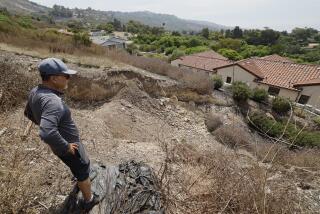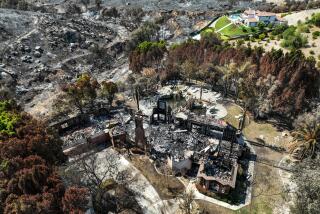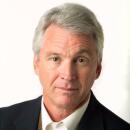Wildfires are costing the state more and that raises big equity issues, Stanford expert says
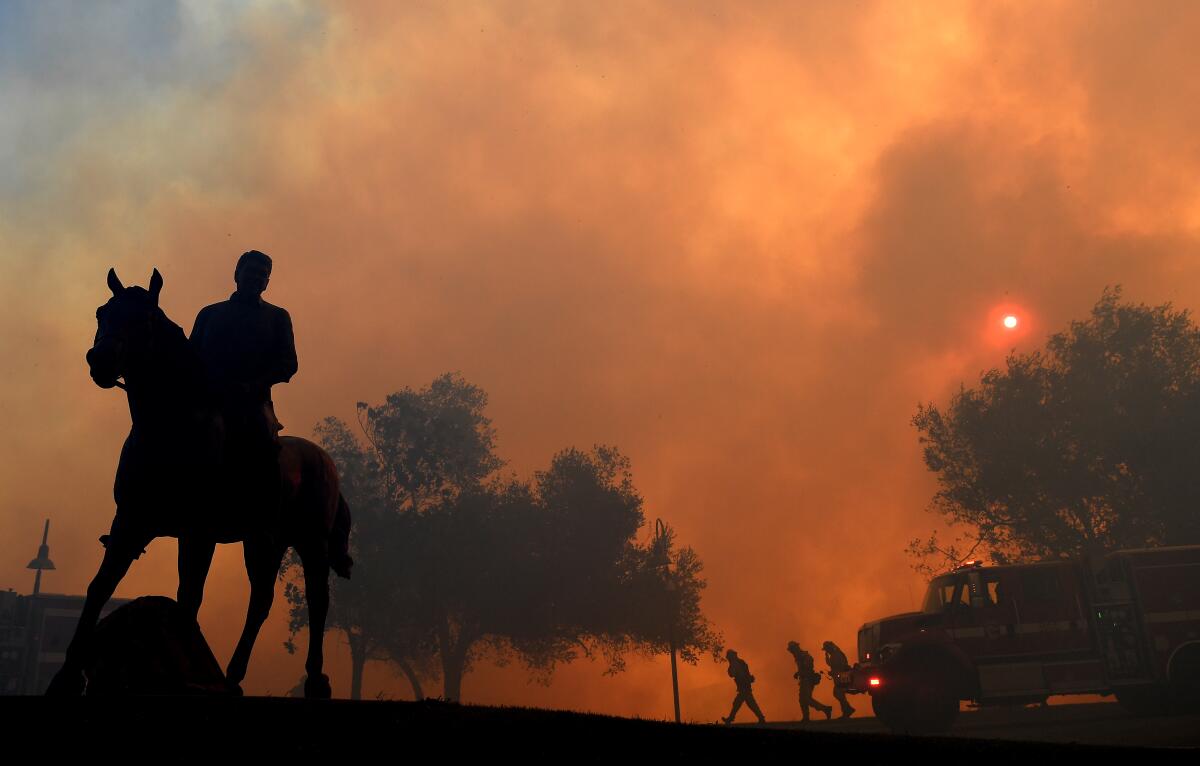
Wildfires touch on a host of issues: Hotter temperatures and drier brush, homes constructed in forested areas, whether homeowners can access insurance and how much it costs.
Like strands inside a power line, the reasons — and possible remedies — to reduce the impact of deadly wildfires in California are varied and intertwined.
Michael Wara, director of the Climate and Energy Policy Program at the Woods Institute for the Environment at Stanford University, constantly thinks about those strands. It’s an issue, he says, that “can’t be overstated.”
The number and intensity of wildfires in the Golden State have increased with deadly consequences. Eight of the 10 most destructive fires in California history have occurred in the past 12 years.
Addressing wildfires touches upon a host of issues, including: Hotter temperatures and drier brush, homes constructed in forested areas, whether homeowners can access insurance and — of course — how much all this will cost beleaguered Californians already saddled with high taxes and utility rates.
Last year in an opinion piece in the Los Angeles Times, Wara gave a “back of the envelope” estimate of $30 billion. And that was before Pacific Gas & Electric came under blistering criticism last month for shutting off power to more than 2 million people across the Bay Area as the Kincade fire roared. Wara and his family were left without electricity for four days.
One of five members of the state’s Commission on Catastrophic Wildfire Cost and Recovery that earlier this year examined issues related to wildfires associated with utility infrastructure, Wara talked to the Union-Tribune recently while he attended the Lesley K. McAllister Symposium on Climate and Energy Law at the Energy Policy Initiatives Center at the University of San Diego. The interview is condensed for space and clarity and incorporates remarks Wara made at the symposium:
What’s going on in California when it comes to wildfires?
This is a combination of a bunch of factors and probably in the absence of climate change, all the other decisions would have been OK.
You think climate change kind of tipped it over the edge?
I think that’s right. But what’s good about that is there’s a bunch of things we can change. We definitely can’t change climate change in the near term. But there’s a lot of things you can change to make our communities safer.
Like what?
Part of it is learning from the experience from San Diego (Gas & Electric) and that includes turning off the grid when the fire threat is high. That’s part of the permanent solution. It is not this temporary thing. I think wildfire is a problem we can make a lot better on a statewide scale, in the ways that San Diego has made it better. But I think that also means there is going to be a lot of people living with power shutoffs for the indefinite future. We need to deal with that.
How do we make sure all the efforts are cost-effective?
I don’t think we should do it in electricity rates. I don’t think it’s possible to do that. I think we need to look to other funding sources and in particular, either bond funding or general fund revenue from the state. There’s a state interest there. And frankly, in the scheme of things, the state has the money to do this. It’s not clear that local governments do. I just think it’s not going to be able to happen in rates.
Why not?
Because if we raised rates to pay for all of this, people are going to exit the system. They’re going to just get solar and leave.
Or they will get solar plus battery storage systems so they can operate when the power shuts off. But wouldn’t that worsen the equity problem — rich people who’ve got solar and people who don’t?
I’m getting there. Everything about fire raises big equity issues. All the solutions we’re talking about here — microgrids and batteries for individual customers — raise huge fairness questions because it is not acceptable to make low-income people in California sit in the dark while the rich have batteries. In places where people have good FICO (credit) scores, they’re getting batteries — right now. They’re not wasting any time. They’re not waiting for some state support. That equity piece I think needs to be the focus.
The other reason I prefer bond funding or general fund revenue is that we can do it fast. Once we’re doing something at the (California Public Utilities Commission) in rates that’s big, it’s going to take a long time just to get to the regulatory process before we’re even deploying things in the field. And we need to be doing this right away. I think we need to be thinking about the next fire season. This fire season, we’ve been lucky.
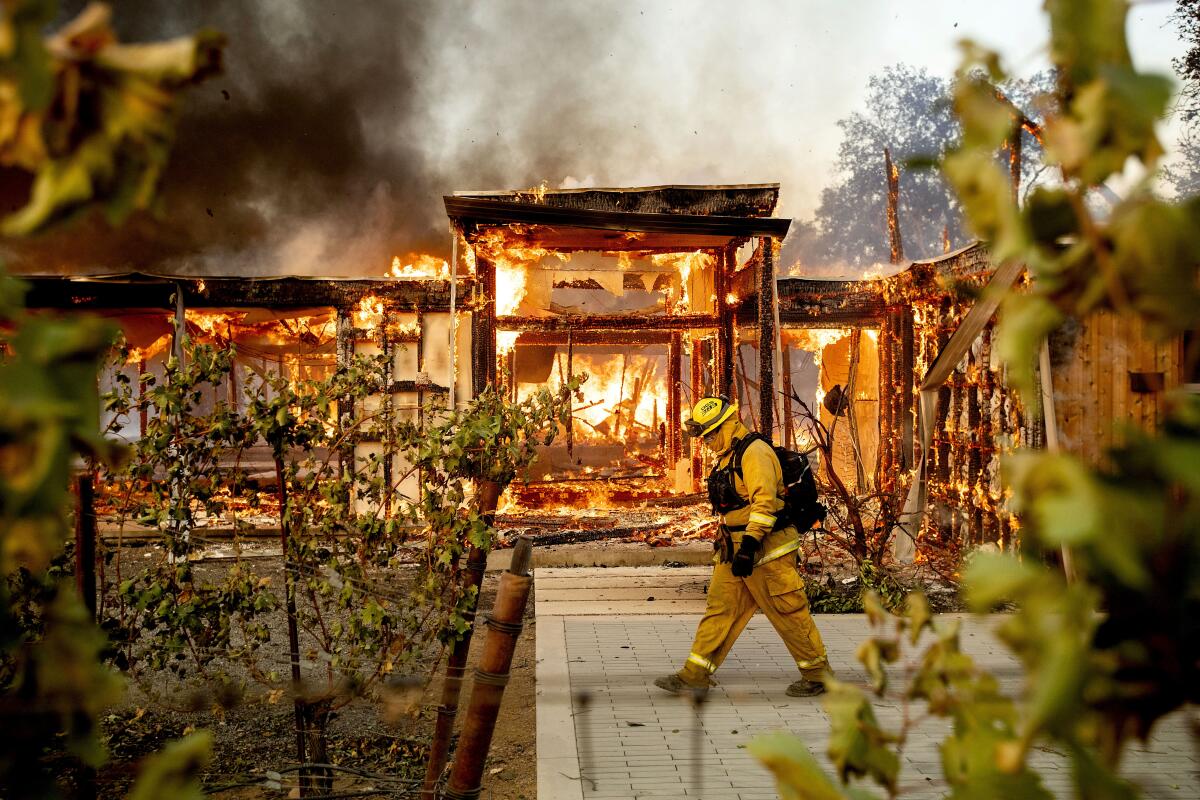
There have only been two big PSPS (Public Safety Power Shutoffs) events (in the Pacific Gas & Electric service territory). We’re not done yet, knock on wood, but we shouldn’t assume that that will continue in the future. We shouldn’t assume we have an extended rainy, late spring. And if we don’t, we’re going to have PSPS events all through the summer, much greater impacts. And so I want to see policies moving where we can get solutions in place for people and for businesses before next fire season. Or at least have the funding streams open up so the private sector can come in and deliver those solutions.
We need to figure out how to do that at the state level because if we don’t, everyone is going to suffer from lack of access and affordability of homeowners insurance, whether their house burns down or not. And that’s a crisis to be avoided. And the good thing about avoiding that crisis and about the kind of battery backup power solution things is both are going to create thousands of jobs in California. Once you’re hardening homes, that’s good blue collar jobs all across high fire threat areas, many of which are struggling economically. So this is a jobs program for those communities.
So, in traditional suburbia, like the way you would hire someone to mow your lawn, you would get someone who comes in once a month and creates defensible space around your house?
Or once a year. And they’re just rotating through your community.
Maybe it would be part of your homeowners’ association or something?
Absolutely, if you’ve got one. Or the fire department comes and visits with you and says, “This year, these are the things you need to do and here’s a list of contractors and here’s a state funding source if it’s means-tested, if you’re low income, so that you can afford to do it.” Because it really needs to be done. All the science says it has to happen at the community level. It does not matter if individual homes do it.
What do you mean?
We’ve got to harden building envelopes. We’ve got to create a noncombustible zone around homes wherever possible. And focus then on defensible space out to 100 feet. And the way to think about this is vaccination. It doesn’t matter if you vaccinate your kids if no one else does. It’s herd immunity, right? Herd immunity is how vaccines work. Herd immunity is how home hardening works, too. So these need to be community-wide programs. Ideally, statewide programs because there’s lots of jurisdictional lines that fires are not going to respect. I think if we don’t provide programs that make this equitable, we won’t get that herd immunity.
Right now in California, if you build a house in a high-risk fire area — what’s called the Wildland-Urban Interface — do you have to pay higher insurance rates?
Yeah, absolutely. And there’s a complicated formula for that, but honestly, you may not be able to get insurance or you may not be able to get standard insurance. Or you will have to go to Lloyd’s of London.
Should there be more restrictions on building houses there?
What we need to make sure of is that homes are being built responsibly, which means much larger setbacks so that the home next door can’t ignite the home next to it. I don’t think we need a blanket ban, but we need to change the economics of building there so that the full cost of building there is incorporated.
If I buy a house and I can’t get insurance, what do I do? Build defensible space and go to an insurance company and say, “Look, I’m doing a good job, please give me insurance?”
No, that’s not gonna work. You need to do it. All of Marin County needs to do it to make that solution attractive to home insurers.
So how does the county do it?
The county needs to have tough enforcement. And ideally, this is where I think the state can really help. We’ve tried to do this in Northern California and it has met enormous local opposition because people like their trees and their leafy environments. And they don’t want to replace it with succulents or crushed granite in a 5-foot ring around their house. And that’s where I think it might be worth it to have the state take some of the heat and say, “You have to do this, but we’re going to provide a lot of resources to help you do it.”
A lot of people, including Gov. Newsom, are angry at PG&E for power shutoffs. Do you think they were necessary?
Yes, I do think they were necessary. I think also that the governor and everyone, myself included, has a right to be angry at PG&E for how they have treated their customers. Their customer relations management has been abysmal and needs to really change.
I think there’s an argument to be made for getting more surgical. San Diego (Gas & Electric) is the best at this. I think PG&E is doing things in a much more crude way. But that’s where we want PG&E to get to. It’s also important when you screw up to apologize to your customers. They have not done that. Bill Johnson published an op-ed in the [San Francisco] Chronicle, but come on. If Zappos loses a pair of shoes that’s being sent to me, I get an email that apologizes and tries to make it right. That’s not how these folks think. And I think there’s a way to incorporate the kind of big data the utilities are beginning to collect into their relationship with their customers. That should be a goal.
I’ve actually been pushing some of the utilities to be a little bit more transparent about that, to start to talk about their wildfire mitigation planning. What is their goal? In the two shutoffs Northern California has just experienced where about 800,000 people were blacked out, if you do everything you want to do in terms of system hardening over the next decade, and you had an event like that, how many people would be blacked out? Is it 500,000? Is it 200,000? You don’t have to be precise about this, but what do you think? Because that’s a really important kind of understanding for people to have and I don’t think they have it yet.
The spur for SDG&E was the 2007 wildfires. Do you think that 2019 is going to be PG&E’s 2007?
I think 2018 with the Camp Fire, or actually, 2017 was. But PG&E was not able — or chose not to — have the kind of “come to Jesus moment” that San Diego Gas & Electric did. My sense from talking to the folks at SDG&E is that they just decided this is unacceptable and if this happens again, our linemen might be attacked in the street. And so we need to just totally change what we’re doing. I think (Southern California) Edison and PG&E need to look outside of the utility space to find the right people to really solve this problem. And they’re not doing that yet.
SDG&E has spent $1.5 billion in ratepayer funds to upgrade their system since the 2007 fires. The service territories of PG&E and Southern California Edison are even bigger. One of the things I’m taking from all this is: This is going to be expensive.
Yes.
And California is already an expensive state to live in. If you were in an elevator with someone and they said, “I want to get this thing fixed.” I guess one of the things you would tell them is, this is going to cost Mr. and Mrs. Taxpayer a lot of money.
I think that’s right. It would be better if it’s Mr. and Mrs. Taxpayer instead of Mr. and Mrs. Ratepayer because taxes are much more progressive. And we can make sure that Mr. Zuckerberg is paying more of the share and a single mom in Bakersfield is paying less.
But everyone is going to have to pay?
Everyone is going to have to pay. And climate change has costs. They are real, they are now. And it’s unfortunate but it’s reality. And I think the main thing is to make sure that the money we do spend is spent effectively and, hopefully, that it has multiple benefits.
These blackouts are really great dress rehearsals for big earthquakes that will inevitably happen. And all of this is making us better for that disaster, which is going to totally dwarf these fires when there finally is a major San Andreas earthquake in the Bay Area. It will be great if there are lots of communities that are able to generate their own power without dependence on centralized infrastructure. Because that infrastructure is going to be very badly damaged. Or we shouldn’t assume that it won’t be.
Nikolewski writes for the San Diego Union-Tribune.
More to Read
Sign up for Essential California
The most important California stories and recommendations in your inbox every morning.
You may occasionally receive promotional content from the Los Angeles Times.


